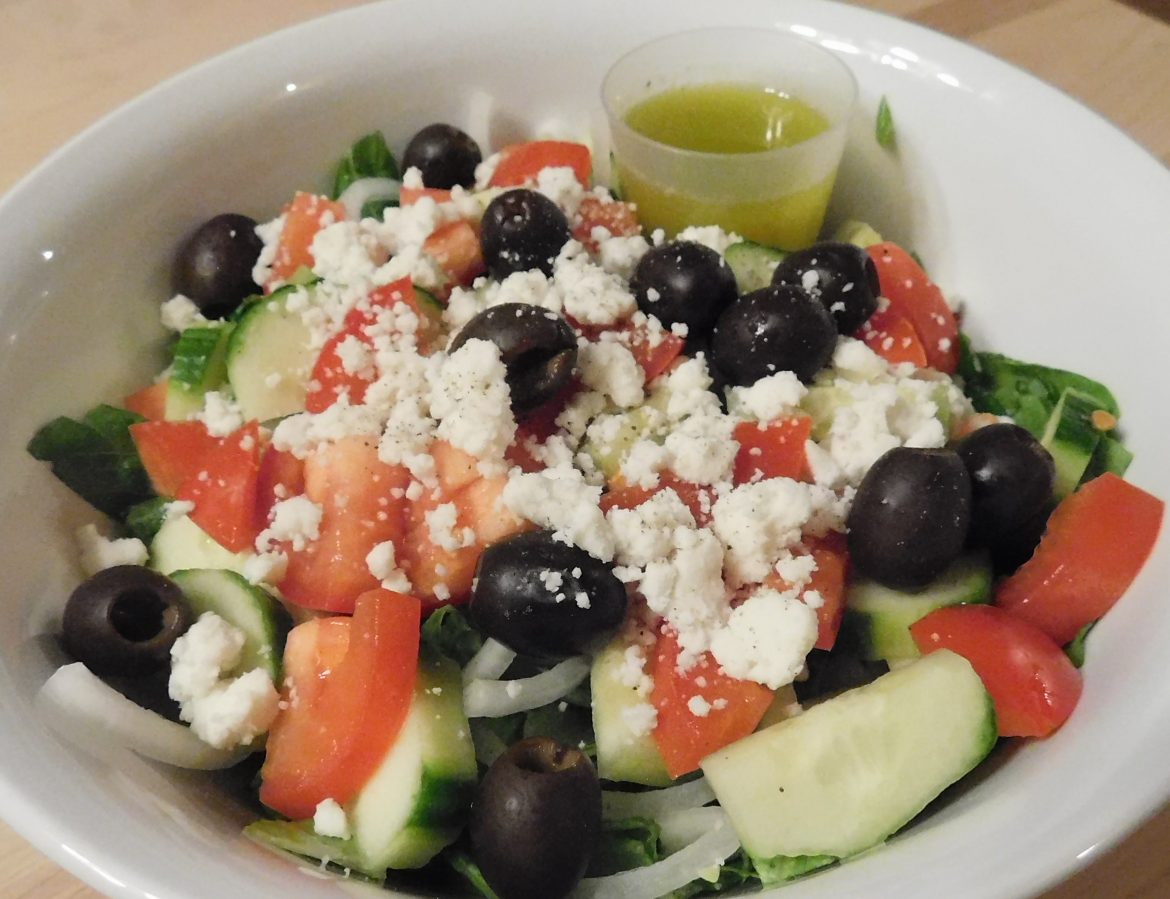Greek Salad
I absolutely love salad with a good dressing! It is the ultimate fast food! I find salad to be very versatile too. You may add different things in it or have it as a side to a meal or as the whole meal. To make most salads more substantial add quinoa or even pasta (First consider how this would taste). This particular post concerns the Greek salad. I will even add some ziti noodles to this salad with or without crumbled falafels for a heavier meal. The combination of salty and tangy really uplifts my spirits. In general, most people who know me know that I have love my Mediterranean food. So, of course I had to come up with a dressing without vinegar or any stimulating/irritating spices!!! Well, consider it done!
The Greek salad also feeds my love of the colorful “rainbow” dishes. Basic Greek salad is made up of olives, feta cheese, romaine, cucumbers, tomatoes, and red onions. With the array of ingredients, the nutritional benefits of this salad include vitamins, minerals, proteins, antioxidants and omega-3 fatty acids. The fatty acids come from the olives and olive oil, which are usually part of Mediterranean dishes.
It should be no secret that the OLIVE is healthy. It’s a food that gives us a command to live: “O LIVE!” Yes, olives are very nutritious, providing both Vitamin A and Vitamin E to the diet. Olives also provide monounsaturated fats, which help relieve rheumatoid arthritis and asthma. My Greek salad was originally made with kalamata olives, which originated in Greece and are usually marinated olive oil, which increases its fat content, and/or in vinegar. The intense flavor of kalamata olives (and its marinated brine) means that a little goes a long way. I now use black olives to avoid the vinegar. However, if I find kalamata olives marinated in lemon juice. That would be my preferred olive for this salad. I usually dice about 8-10 olives in one family-sized salads and that is usually enough. Now, olive oil (remember cold-pressed extra virgin) is high in Omega-3 and Omega-6 fats, which are good for you. Though I will always tell you to google the benefits, click the link to digest some nutritional facts about olive oil. By the way, my parents once had me to drink a concoction, primarily made with olive oil, to pass a significant and painful blockage (which turned out to be a build up of dairy cheese) in my colon. It is also very good to ease constipation.
Now, this Greek salad dressing is missing the black pepper and vinegar. Just like I left out the kalamata olives because of vinegar, I only used lemon juice and provided the kick with a very tiny pinch of Vitamin C. This truly makes it taste the same and boosts your immune system. *smile* I call that a “win-win!” Now, I use the NOW brand of Vitamin C, but if you do not have access to that, it gets a bit tricky. We know that Vitamin C is in our citrus fruits, and we may use these too. You are already squeezing a whole lemon. My advice if you want to use this skin for instead of the powder is to peel the lemon. Take just a very small piece of the skin that’s surrounding the meat of the lemon and blend it. Taste it! If this isn’t producing that sharpness, try another piece, but the warning is that this way can go South fast! Be very careful and taste every time.
So now you’re probably thinking, “Greek salad has feta cheese, and there’s nothing plant-based about that!” Well, it is if you make it from a plant source, which is leftover plant-based milk pulp in this case. I am always discovering new recipes. Many of you know that this is different than the recipe I had in my 2013 blog or even in my last blog. In the past, I’ve made feta with tofu and marinated it for a few days, but then I changed to another recipe that was softer and more crumbly (See Vegan Cashew Bryndza (feta-like cheese) recipe from the Cook with the Blue Raven blog. Now I make my feta a bit differently … from the pulp of the coconut-almond blend I use to make my plant-based yogurt or any almond milk pulp I may use because I am on a NO-WASTE quests and my refrigerator/freezer started to build up with this pulp and I had to find a use for it. Hence, this new feta, which I absolutely love…and the feta-ish crumbles (Recipe) has a touch of this plant-based yogurt (Coco-Yo Recipe) in it as well.
Now, without further ado, here is the recipe. I feel that I must also relate to my readers that in my salads I use all organic ingredients where necessary to avoid those pesky endocrine resistors from pesticides. I highly recommend this, but if not possible, wash your veggies well with baking soda and always pray for God’s blessings on your food! Amen!
Greek Salad with Delicious Greek Salad Dressing
Greek Salad Ingredients:
- Romaine lettuce
- Grape tomatoes (or whole tomatoes chopped)
- English cucumber (or any cucumber)
- Red onion (organic not necessary)
- Pitted black olives
- Pepperocini peppers (optional, I always leave these out)
- Feta-ish crumbles (See recipe!)
Instructions: Place salad ingredients into a large salad bowl, toss, and set aside.
If you’re like me and make about three or four servings of salad at one time, then remember to only put dressing and the feta-ish crumbles on the salad that you are going to presently consume. Otherwise, the oil in these recipes will cause your salad to wilt. See below for the delicious Greek salad dressing recipe.
Greek Salad Dressing Ingredients:
- ½ cup extra virgin, cold-pressed olive oil
- 1 fresh lemon, squeezed
- 2 teaspoons dried oregano
- 1 ½ teaspoons garlic, minced (about 1 large clove)
- ½ teaspoon dried basil
- 1 teaspoon olive brine (black olives) or plant-based broth
- ½ – ¾ teaspoon pink Himalayan salt
- ¼ teaspoon agave/honey/ or ½ teaspoon raw unrefined cane sugar
- ½ teaspoon fresh ground Monk’s/papaya pepper
- An itsy-bitsy, teeny-tiny pinch of NOW Vitamin C powder (i.e., scanty 1/128 teaspoon *smile*), or add a small piece of the INSIDE of a lemon peel or the SKIN of the lemon AFTER it’s peeled (very tiny, but this takes trial and error as it is less precise) — Too much of either will ruin this dressing. I may make a video to show you in the near future.
Instructions:
- Add the ingredients to a blender (like a magic bullet/nutribullet), and blend until combined.
- Pour into a salad dressing bottle to store. Always shake mixture before using.
- Store tightly covered at room temperature if using right away. Store in the refrigerator. Makes a bit more than a half cup of dressing.
Note: If you’re all about refrigeration too, then remember to take the salad dressing out of the refrigerator at least 30 minutes before using to allow the oil to liquefy.
Enjoy!





